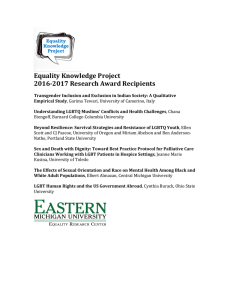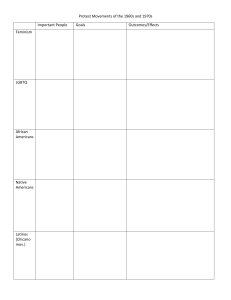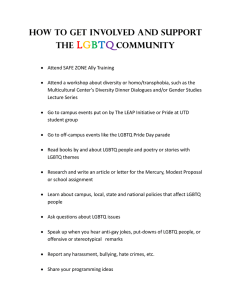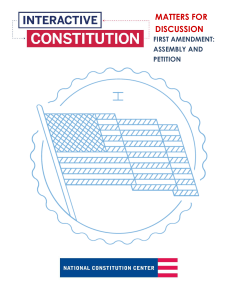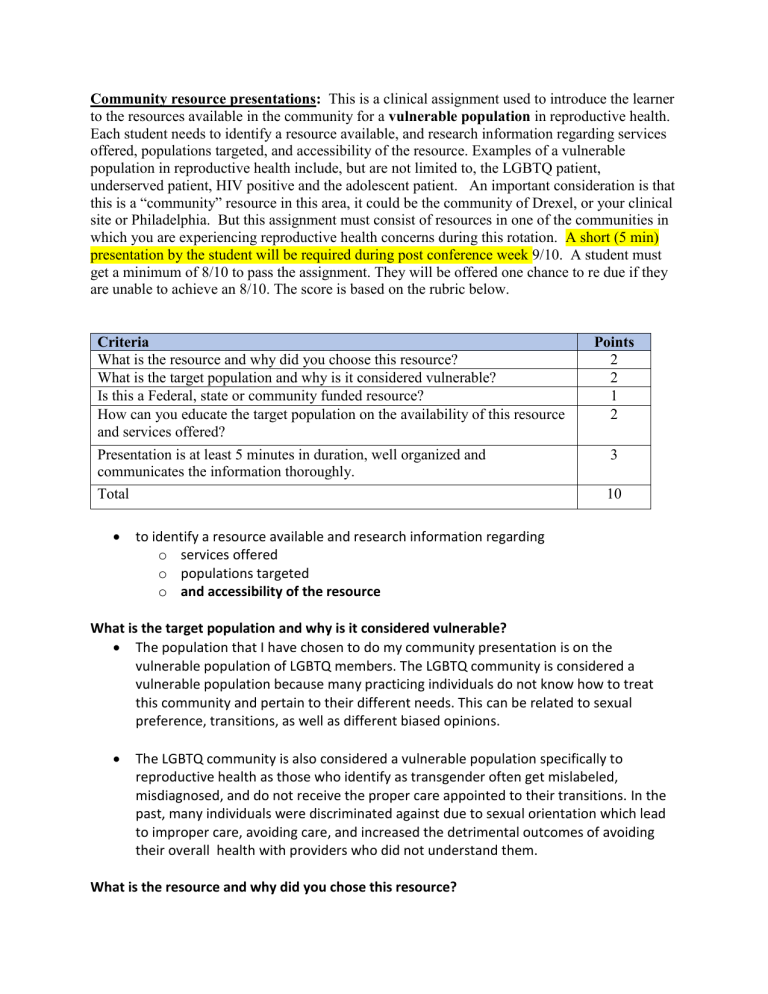
Community resource presentations: This is a clinical assignment used to introduce the learner to the resources available in the community for a vulnerable population in reproductive health. Each student needs to identify a resource available, and research information regarding services offered, populations targeted, and accessibility of the resource. Examples of a vulnerable population in reproductive health include, but are not limited to, the LGBTQ patient, underserved patient, HIV positive and the adolescent patient. An important consideration is that this is a “community” resource in this area, it could be the community of Drexel, or your clinical site or Philadelphia. But this assignment must consist of resources in one of the communities in which you are experiencing reproductive health concerns during this rotation. A short (5 min) presentation by the student will be required during post conference week 9/10. A student must get a minimum of 8/10 to pass the assignment. They will be offered one chance to re due if they are unable to achieve an 8/10. The score is based on the rubric below. Criteria What is the resource and why did you choose this resource? What is the target population and why is it considered vulnerable? Is this a Federal, state or community funded resource? How can you educate the target population on the availability of this resource and services offered? Presentation is at least 5 minutes in duration, well organized and communicates the information thoroughly. Total Points 2 2 1 2 3 10 to identify a resource available and research information regarding o services offered o populations targeted o and accessibility of the resource What is the target population and why is it considered vulnerable? The population that I have chosen to do my community presentation is on the vulnerable population of LGBTQ members. The LGBTQ community is considered a vulnerable population because many practicing individuals do not know how to treat this community and pertain to their different needs. This can be related to sexual preference, transitions, as well as different biased opinions. The LGBTQ community is also considered a vulnerable population specifically to reproductive health as those who identify as transgender often get mislabeled, misdiagnosed, and do not receive the proper care appointed to their transitions. In the past, many individuals were discriminated against due to sexual orientation which lead to improper care, avoiding care, and increased the detrimental outcomes of avoiding their overall health with providers who did not understand them. What is the resource and why did you chose this resource? Specifically, the resource that I chose has to do with Penn’s Reproductive health program geared towards the LGBTQ community. The program encompasses care for gynecology and obstetrical care as well as overall health for other members related to LGBTQ. o Penns resource offers patient centered care that is considered equal and unbiased. They also have doctors who are both LGBTQ and Straight identifying (allys), and can better help this vulnerable community by addressing concerns more relatable to their needs. Penn is versatile in 5 areas of focus which are, visibility, education, research, care, and community outreach. o They have qualifications such as research including the care of LGBTQ identifying patients. Community outreach such as including organizations to include in their research studies. Penn is outreaching to a community that has not received proper health care by including them in their studies. Patient centered care alongside research can lead to better outcomes in this community geared towards their needs. The promotion for equity and equality in provided by the care that revolves around the needs of the individual and the community. Penn has even been deemed “Leader in LGBT health care equality” by the human rights campaign o I think that this is a wonderful resource to help those who are unable to get access care. This is important as not all hospitals have a program like this. The important of knowledge and research for a target population is important in addressing proper care and catering to the needs of the community. Care provided o Preferred name, pronouns, gender affirming o Appropriate providers in a comfortable safe environment o Records are up to date to match gender and designation o Patient Advocate program that can help you connect to LGBTQ competent providers and navigate the ins and outs of care at Penn Primary care + related to endocrinology PREP services: HIV medications Hormone replacement therapy Surgical procedures which include Penn Plastic Surgery – gender affirming procedures Body contouring o Top surgery o Facial feminization and facial masculinization Otolaryngology (Head + Neck) o Voice gender Urogynecology o Hysterectomy (removal of cervix, uterus, fallopian tubes) Urology o Orchiectomy (removal of testes) Mental health & substance abuse o Counseling, therapy, family counseling Education on target population I think that a way we can promote this idea for our target population would be to have fliers around campus or in hospitals. Outside of the clinic is the best form of action as many avoid going to clinics if they are uncomfortable. I think wide spreading on social media as well as having organizations spread the word would be a good idea. I also believe that having Penn itself reach out to different organizations regarding counseling, different organizations would be a great way to promote visibility of their program.

